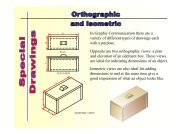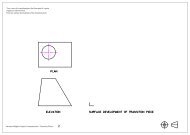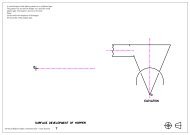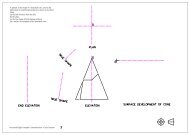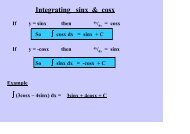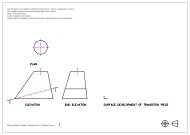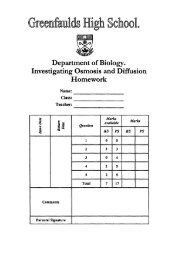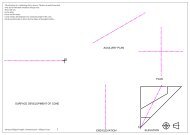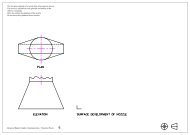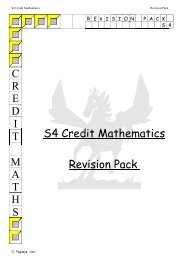2005 paper 2 solution
2005 paper 2 solution
2005 paper 2 solution
You also want an ePaper? Increase the reach of your titles
YUMPU automatically turns print PDFs into web optimized ePapers that Google loves.
Higher Maths <strong>2005</strong><br />
Paper 2 Solutions<br />
1.<br />
<br />
3<br />
4x<br />
−1<br />
x<br />
2<br />
x<br />
=<br />
=<br />
<br />
<br />
4x<br />
=<br />
2<br />
= 2x<br />
<br />
<br />
4x<br />
2<br />
x<br />
1<br />
−<br />
x<br />
−2<br />
( 4x<br />
− x )<br />
2<br />
2<br />
3<br />
−1<br />
2<br />
x<br />
− + c<br />
−1<br />
1<br />
+ + c<br />
x<br />
<br />
dx<br />
<br />
dx<br />
2. (a) sin(p + q) = sinpcosq + cospsinq (b) cos(p + q) = cospcosq – sinpsinq<br />
=<br />
15<br />
17<br />
4 8 3<br />
⋅ + ⋅<br />
=<br />
5 17 5<br />
8<br />
17<br />
4 15 3<br />
⋅ − ⋅<br />
5 17 5<br />
=<br />
60 24<br />
32 45<br />
+ = −<br />
85 85<br />
85 85<br />
84<br />
= 85<br />
=<br />
13<br />
−<br />
85<br />
(c) tan(p + q) =<br />
=<br />
=<br />
sin( p + q)<br />
cos( p + q)<br />
84<br />
85<br />
13<br />
−<br />
85<br />
84 85 × −<br />
85 13<br />
=<br />
84<br />
−<br />
13<br />
Solutions by MAitchison www.mathsroom.co.uk
3. (a) m AB =<br />
( y<br />
( x<br />
2<br />
2<br />
− y1)<br />
− x )<br />
1<br />
midpoint = (3,2)<br />
(4 − 0)<br />
=<br />
(5 −1)<br />
4<br />
= 4<br />
y – b = m(x – a)<br />
y – 2 = –1(x – 3)<br />
= 1 y – 2 = –x + 3<br />
m chord = –1 as m 1 .m 2 = –1 for lines x + y = 5<br />
(b) m T =<br />
1<br />
− (c) Perpendicular bisector of AB (answer (a))<br />
3<br />
m r = 3 and radius CA will intersect at centre, C.<br />
y – b = m(x – a) x + (3x – 3) = 5<br />
y – 0 = 3(x – 1) 4x = 8<br />
y = 3x – 3 x = 2<br />
y = 3<br />
C(2,3)<br />
r =<br />
r =<br />
2<br />
( xC<br />
− xA<br />
) + ( yC<br />
− y A<br />
2<br />
( 2 − 1) + (3 − 0)<br />
2<br />
)<br />
2<br />
r =<br />
2<br />
( 1) + (3)<br />
2<br />
r = 10<br />
Equation of circle: (x – 2) 2 + (y – 3) 2 = 10<br />
Solutions by MAitchison www.mathsroom.co.uk
4. (a)<br />
TA =<br />
− 5<br />
<br />
15 <br />
<br />
1 <br />
− 40<br />
<br />
TB = 15 <br />
(b) TA =<br />
<br />
2 <br />
2<br />
( − 5) + (15) + (1)<br />
= 251<br />
2<br />
2<br />
TB =<br />
2<br />
( − 40) + (15) + (2)<br />
2<br />
2<br />
= 1829<br />
cosA =<br />
cosA =<br />
a ⋅b<br />
a b<br />
cosA = 0.631<br />
A = 50.9°<br />
( −5)(<br />
−40)<br />
+ (15)(15) + (1)(2)<br />
251. 1829<br />
5. For points of intersection y = y<br />
2x 2 – 9 = x 2 2 2<br />
A = ( x − (2x<br />
− 9)) dx<br />
−<br />
x 2 – 9 = 0 = ( 9 − x dx<br />
−<br />
3<br />
3<br />
3<br />
3<br />
2 )<br />
(x + 3)(x – 3) = 0 =<br />
3 <br />
9x<br />
− x<br />
<br />
3<br />
3<br />
− 3<br />
<br />
x = –3, 3 = <br />
(3)<br />
9(3) −<br />
3<br />
= (27 – 9) – (–27 + 9)<br />
= 18 – (–18)<br />
= 36 units 2<br />
3<br />
<br />
<br />
( −3)<br />
− 9( −3)<br />
−<br />
3<br />
3<br />
<br />
<br />
<br />
Solutions by MAitchison www.mathsroom.co.uk
6. y =<br />
24<br />
x<br />
2<br />
y = 24x −1<br />
y =<br />
when x = 4<br />
dy =<br />
2<br />
−12x −3<br />
y = 12<br />
dx<br />
dy −12<br />
=<br />
dx<br />
3<br />
( x)<br />
24<br />
(4)<br />
dy −12 =<br />
dx<br />
3<br />
(4)<br />
dy 12 = −<br />
dx 8<br />
dy 3 = −<br />
dx 2<br />
P(4,12) m =<br />
y – b = m(x – a)<br />
y – 12 =<br />
3<br />
− (x – 4)<br />
2<br />
2y – 24 = –3x + 12<br />
3x + 2y = 36<br />
3<br />
−<br />
2<br />
7. log 4 (5 – x) – log 4 (3 – x) = 2<br />
(5 − x)<br />
log 4<br />
(3 − x)<br />
4 2 =<br />
16 =<br />
= 2<br />
(5 − x)<br />
(3 − x)<br />
(5 − x)<br />
(3 − x)<br />
16(3 – x) = 5 – x<br />
48 – 16x = 5 – x<br />
43 = 15x<br />
43 = x<br />
15<br />
Solutions by MAitchison www.mathsroom.co.uk
8. For points of intersection y = y<br />
<br />
ksin2x = sinx<br />
k × 2sinxcosx = sinx<br />
2ksinxcosx – sinx = 0<br />
sinx(2kcosx – 1) = 0<br />
sinx = 0 or 2kcosx – 1 = 0<br />
x = 0, , 2 2kcosx = 1<br />
cosx =<br />
1<br />
2k<br />
<br />
From diagram, x = 0, , 2 correspond to points O, B and D respectively.<br />
Hence, at A and C, cosx =<br />
1 .<br />
2k<br />
9. (a) At launch, t = 0 (b) 20 = 252e –0.06335t<br />
V = £252 million<br />
20<br />
252<br />
= e –0.06335t<br />
20 <br />
.06335<br />
log e = loge ( )<br />
252 <br />
e−0 t<br />
20 <br />
log e = –0.06335t<br />
252 <br />
20 <br />
loge<br />
<br />
252<br />
t =<br />
<br />
− 0.06335<br />
t = 40 years<br />
Solutions by MAitchison www.mathsroom.co.uk
10. a(a + b + c)<br />
= aa + ab + ac<br />
= a 2 + abcos90° + accos60°<br />
= (3) 2 + 0 + (3)(3)cos60°<br />
= 9 + 9. 2<br />
1<br />
= 13.5<br />
11. (a)<br />
–1 1 p p 1<br />
–1 1 – p –1<br />
1 p – 1 1 0<br />
x = –1 is a <strong>solution</strong><br />
(b) Quotient: x 2 – (p – 1)x + 1<br />
For real roots b 2 – 4ac 0<br />
y<br />
(p – 1) 2 – 4(1)(1) 0<br />
p 2 – 2p + 1 – 4 0<br />
p 2 – 2p – 3 0<br />
(p + 1)(p – 3) 0<br />
O<br />
–1 3<br />
x<br />
p –1 and p 3 for all roots of the cubic function to be real.<br />
Solutions by MAitchison www.mathsroom.co.uk



